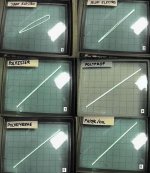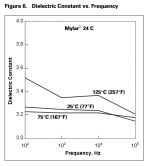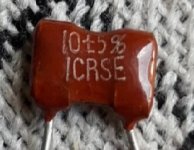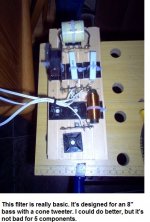Got to love the speaker cables and capacitor debates.
Obviously the real world test is the listening test.
So will be interesting all together.
Of course a lot of car stereos come with basic fullrange speakers with whizzer cones.
And even a cheap pair of 3 way upgrades, improve the sound.
Of course these 3 way speakers if used in home audio
Instantly sound horrible according
to most.
To upgrade home audio you need a fullrange driver with a whizzer cone.
We can solve all problems instantly.
Put the home audio speakers in your car.
Then use the fullrange factory car drivers in your home.
And everything will sound great.
I have to agree though. Painting every wall a different color.
Will help with high frequency response.
It only works if you use the highest priced paint.
Then again if your a music lover.
For some reason the speaker quality in the garage
never matters.
And in the living room its a bigger deal.
Music changes depending on what room your in.
Obviously the real world test is the listening test.
So will be interesting all together.
Of course a lot of car stereos come with basic fullrange speakers with whizzer cones.
And even a cheap pair of 3 way upgrades, improve the sound.
Of course these 3 way speakers if used in home audio
Instantly sound horrible according
to most.
To upgrade home audio you need a fullrange driver with a whizzer cone.
We can solve all problems instantly.
Put the home audio speakers in your car.
Then use the fullrange factory car drivers in your home.
And everything will sound great.
I have to agree though. Painting every wall a different color.
Will help with high frequency response.
It only works if you use the highest priced paint.
Then again if your a music lover.
For some reason the speaker quality in the garage
never matters.
And in the living room its a bigger deal.
Music changes depending on what room your in.
Last edited:
Boy, Wolf, I couldn't agree with you more.
And one of the best examples is the tube connector scam that has already separated a lot of people from their hard earned money.
What's a tube connector? Do you mean a coupling capacitor, or the tube socket, or the tube pins?
Tube Connector
The 'tube connector' is a US$50 pr (!) plastic encased copper tube, into which you plug the output wires from your speaker crossover at one end, and the wires to the speaker at the other and I think they join in the middle. This allegedly makes a significant improvement to the sound over binding posts......hmmm.
If that really was a good idea, it seems to me that you could do the same thing for free just by directly connecting the speaker wires to the output from the crossover rather than use binding posts.
The $50 could be better used to buy something which would undoubtedly, definitely improve your system's sound: the "Huh" brand organic, spring water washed, acoustically balanced special rocks speaker feet!
Geoff
The 'tube connector' is a US$50 pr (!) plastic encased copper tube, into which you plug the output wires from your speaker crossover at one end, and the wires to the speaker at the other and I think they join in the middle. This allegedly makes a significant improvement to the sound over binding posts......hmmm.
If that really was a good idea, it seems to me that you could do the same thing for free just by directly connecting the speaker wires to the output from the crossover rather than use binding posts.
The $50 could be better used to buy something which would undoubtedly, definitely improve your system's sound: the "Huh" brand organic, spring water washed, acoustically balanced special rocks speaker feet!
Geoff
Tube connectors are wiring connectors sold by GR Research as an alternative to binding posts for attaching cables to speakers.
The seller makes ridiculous claims about the audio performance improvement using tube connectors. And like the posts made by some here claiming differences from using higher cost capacitors there is no real evidence or proof of any improvement. No impartial well designed comparison tests. Just a lot of fan club nonsense.
You can find lots of discussion about tube connectors over at the AudioCircle website where GR Research has a major paid for presence. The tube connector fan club there is so strong and ridiculous that I sometimes use it as a benchmark for showing what is obviously very strong confirmation bias.
The seller makes ridiculous claims about the audio performance improvement using tube connectors. And like the posts made by some here claiming differences from using higher cost capacitors there is no real evidence or proof of any improvement. No impartial well designed comparison tests. Just a lot of fan club nonsense.
You can find lots of discussion about tube connectors over at the AudioCircle website where GR Research has a major paid for presence. The tube connector fan club there is so strong and ridiculous that I sometimes use it as a benchmark for showing what is obviously very strong confirmation bias.
Last edited:
The problem with plugs is they corrode... I prefer to hard solder as much as I can. 😀
In a World First I can present some actual capacitor measurements. Beats all the Snake-Oil, IMO.
What I conclude from that is that electrolytics are slightly worse than film types.
Film types look all the same to me! But maybe Silver and Gold rather than plain old Copper makes you feel better.
In a World First I can present some actual capacitor measurements. Beats all the Snake-Oil, IMO.
What I conclude from that is that electrolytics are slightly worse than film types.
Film types look all the same to me! But maybe Silver and Gold rather than plain old Copper makes you feel better.
Attachments
Film types look all the same to me! But maybe Silver and Gold rather than plain old Copper makes you feel better.
In Oz, a Jantzen "Cross Cap" 5.6 microfarad film cap retails for A$8.50; I've used Cross Caps in most of my builds and found them fine.
But for - wait for it - A$650.00 I could buy an "Amber Z Cap" (copper film) of the same value: how on earth could that really make that much difference to the sound?
This is not a reflection on the retailer, whose products are well priced and good value, but more a "huh?" on my part that there's a market for that sort of thing.
Geoff
Giving credit where it's due, the scope images of cap measurements Steve posted above originate from Steve Bench's tube page, which GM and I occasionally link to, and is well worth a read:
The "Sound" of Capacitors
The Sound of Capacitors - Electrolytics
The Sound of Capacitors - Ceramics
The "Sound" of Capacitors
The Sound of Capacitors - Electrolytics
The Sound of Capacitors - Ceramics
Watching Danny's videos is quite funny or soporific, depending what mood I'm in, he sounds so incredibly bored by what he's saying.Tube connectors are wiring connectors sold by GR Research as an alternative to binding posts for attaching cables to speakers.
The seller makes ridiculous claims about the audio performance improvement using tube connectors. And like the posts made by some here claiming differences from using higher cost capacitors there is no real evidence or proof of any improvement. No impartial well designed comparison tests. Just a lot of fan club nonsense.
You can find lots of discussion about tube connectors over at the AudioCircle website where GR Research has a major paid for presence. The tube connector fan club there is so strong and ridiculous that I sometimes use it as a benchmark for showing what is obviously very strong confirmation bias.
The only really convincing measurement of crossover problems I have ever found was mutual interference between coils, and coils being affected by nearby thick ground planes.
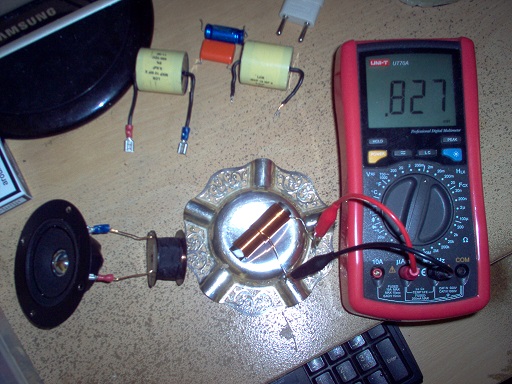
My 1mH ferrite coil measured 0.827mH due to a ground plane. Here a silver ashtray of high conductivity. Thin tinfoil had no effect. FWIW, aircoils are measureably better than ferrites on hysteresis and avoid saturation.
The tweeter picked up the 1kHz whine from the inductance meter too. You could hear it. Capacitors were unaffected by nearby coils.
My takeaway was mount coils at right angles or far apart. And point to point wiring might be better than PCBs for crossovers. I have some substantial generic 630V capacitors, but am unconvinced they work better than cheaper, smaller 250V types.
My 1mH ferrite coil measured 0.827mH due to a ground plane. Here a silver ashtray of high conductivity. Thin tinfoil had no effect. FWIW, aircoils are measureably better than ferrites on hysteresis and avoid saturation.
The tweeter picked up the 1kHz whine from the inductance meter too. You could hear it. Capacitors were unaffected by nearby coils.
My takeaway was mount coils at right angles or far apart. And point to point wiring might be better than PCBs for crossovers. I have some substantial generic 630V capacitors, but am unconvinced they work better than cheaper, smaller 250V types.
Attachments
Watching Danny's videos is quite funny or soporific, depending what mood I'm in, he sounds so incredibly bored by what he's saying.
I'm not put off so much by his style as by his actual comments.
I find it very hard to accept much of what he claims.
RESULTS
I was successful at upgrading one speaker and getting the set in place for testing without knowing which one was upgraded. I did this by having my son position the speakers in the room. We moved these speakers out of the garage and into the house where I regularly listen. I’m played them with my Harman Kardon TA 5000x, mostly in mono so they get the same input. I listened with A on the right channel and B on the left, and then I switched them and listened again. I have serval hours of listening to all types of music on these as I work from home and my system on all day. Also, after a couple of days I switch out the receiver with a DH-100 pre-amp and Speakercraft BB275 amp to getting a differ take. My impression is that they sound a lot more the same then different and I had to spend a lot of time with the balance knob to find any differences at all. But I could not detect any differences that were consistently detectable when I switched music, receivers, etc.
So my conclusion, with my ears and these speakers I could not tell the difference between the slightly better main caps with high end bypass caps and the cheapest crossover film caps that you can get.
I was successful at upgrading one speaker and getting the set in place for testing without knowing which one was upgraded. I did this by having my son position the speakers in the room. We moved these speakers out of the garage and into the house where I regularly listen. I’m played them with my Harman Kardon TA 5000x, mostly in mono so they get the same input. I listened with A on the right channel and B on the left, and then I switched them and listened again. I have serval hours of listening to all types of music on these as I work from home and my system on all day. Also, after a couple of days I switch out the receiver with a DH-100 pre-amp and Speakercraft BB275 amp to getting a differ take. My impression is that they sound a lot more the same then different and I had to spend a lot of time with the balance knob to find any differences at all. But I could not detect any differences that were consistently detectable when I switched music, receivers, etc.
So my conclusion, with my ears and these speakers I could not tell the difference between the slightly better main caps with high end bypass caps and the cheapest crossover film caps that you can get.
Hello all. I used to get caught up in the cap thing. Now I'll replace them in both channels of a pair of speakers, but only if one or both of each channel is done, in case there are differences.
An issue I talked about with a tech fixing my Naim amp years ago, was the tolerances. According to him, he toured a Naim facility years and years prior to my visit. He told me Naim had drawers and drawers of various caps, each sorted to within less than 1% of their printed value, including the ones far out of their printed values. My problem with blithely changing a capacitor is whether or not a replacement should be exchanged for one of the printed value. I've often seen electrolytics with +/- tolerances printed on the jacket, and have no way of knowing if a manufacturer wanted the printed value, or a variance in the tolerance.
I feel more confident with the much tighter tolerances in film capacitors. Even then, I suppose one could even measure the driver and cap from a good channel, and try matching that with the cap/driver combinationon the channel being fixed.
An issue I talked about with a tech fixing my Naim amp years ago, was the tolerances. According to him, he toured a Naim facility years and years prior to my visit. He told me Naim had drawers and drawers of various caps, each sorted to within less than 1% of their printed value, including the ones far out of their printed values. My problem with blithely changing a capacitor is whether or not a replacement should be exchanged for one of the printed value. I've often seen electrolytics with +/- tolerances printed on the jacket, and have no way of knowing if a manufacturer wanted the printed value, or a variance in the tolerance.
I feel more confident with the much tighter tolerances in film capacitors. Even then, I suppose one could even measure the driver and cap from a good channel, and try matching that with the cap/driver combinationon the channel being fixed.
Tube connectors? They sound like those battery connectors you can get for RC cars, a bag of 20 for a few quid, and Z plugs fit in them lovely. Gold plated as well. I just use a terminal block, twist wires from the crossover with the speaker cable, stick 'em in the terminal block and tighten up the screws. The terminal block just stops the wires untwisting or touching adjacent wires. I use car full range drivers for my hifi, but they needed a contour network to reduce the midrange.
Hey Wgh64
Thanks for reporting on this. I was dragging my Tritrix around yesterday and though about this thread. This pair is going to my brother and I had to reglue some of the Xover parts to the board.
Thanks for reporting on this. I was dragging my Tritrix around yesterday and though about this thread. This pair is going to my brother and I had to reglue some of the Xover parts to the board.
RESULTS
I was successful at upgrading one speaker and getting the set in place for testing without knowing which one was upgraded. I did this by having my son position the speakers in the room. We moved these speakers out of the garage and into the house where I regularly listen. I’m played them with my Harman Kardon TA 5000x, mostly in mono so they get the same input. I listened with A on the right channel and B on the left, and then I switched them and listened again. I have serval hours of listening to all types of music on these as I work from home and my system on all day. Also, after a couple of days I switch out the receiver with a DH-100 pre-amp and Speakercraft BB275 amp to getting a differ take. My impression is that they sound a lot more the same then different and I had to spend a lot of time with the balance knob to find any differences at all. But I could not detect any differences that were consistently detectable when I switched music, receivers, etc.
So my conclusion, with my ears and these speakers I could not tell the difference between the slightly better main caps with high end bypass caps and the cheapest crossover film caps that you can get.
Nice! Now take those caps and set them aside for your next build. I tend to go with clarity cap PX and CSA on the tweeters. Mid-fi speakers get Solen at my house. High end stuff gets clarity cap. I haven't A/B'ed them though.
Thank you for your honest review.
RESULTS
I was successful at upgrading one speaker and getting the set in place for testing without knowing which one was upgraded. I did this by having my son position the speakers in the room. We moved these speakers out of the garage and into the house where I regularly listen. I’m played them with my Harman Kardon TA 5000x, mostly in mono so they get the same input. I listened with A on the right channel and B on the left, and then I switched them and listened again. I have serval hours of listening to all types of music on these as I work from home and my system on all day. Also, after a couple of days I switch out the receiver with a DH-100 pre-amp and Speakercraft BB275 amp to getting a differ take. My impression is that they sound a lot more the same then different and I had to spend a lot of time with the balance knob to find any differences at all. But I could not detect any differences that were consistently detectable when I switched music, receivers, etc.
So my conclusion, with my ears and these speakers I could not tell the difference between the slightly better main caps with high end bypass caps and the cheapest crossover film caps that you can get.
wgh64,
The results you found are pretty much in line with those that several people here predicted. That there would be no discernable difference from more expensive capacitors.
But I think it was still a good thing for you to have proven it to yourself. That eliminates any doubt or nagging thoughts about whether to change out the capacitors or not.
There is a great deal of misinformation about audio on these various forums and it’s very frustrating for people who have real technical backgrounds and know that certain things just can’t be true.
There are, of course, major differences in sound from various speakers. Drivers are primarily a mechanical device and it should be expected that they will all sound different.
But when it comes to electrical components the differences are very narrow. Complex active equipment like amplifiers and DACs certainly can somewhat sound different, but substituting more expensive passive components like capacitors, resistors, and connectors really can’t change the sound.
And despite the many posts about cables they have virtually no effect on the sound. A small case can be made that cable capacitance in speaker cables can slightly roll off some of the higher audio frequencies, particularly if they are long cables, but no case can be made for any effect on the bass assuming the cable is of decent gauge
Nevertheless people will waste thousands of dollars on exotic speaker cables and claim to hear major differences. They really have to make those claims or they cannot justify to themselves why they spent and wasted so much money.
Last edited:
I admit I expected to hear a difference but was not that surprised when I couldn't. I know I spent some money learning this but I expect I'll save hundreds of dollars in the future by having this first-hand experience; one more lesson learned at the school of hardknocks. Thanks to everyone for reading this thread and particularly to those of you that shared your experiences.
- Home
- Loudspeakers
- Multi-Way
- Do Capacitors Matters - A $100± dollar upgrade
